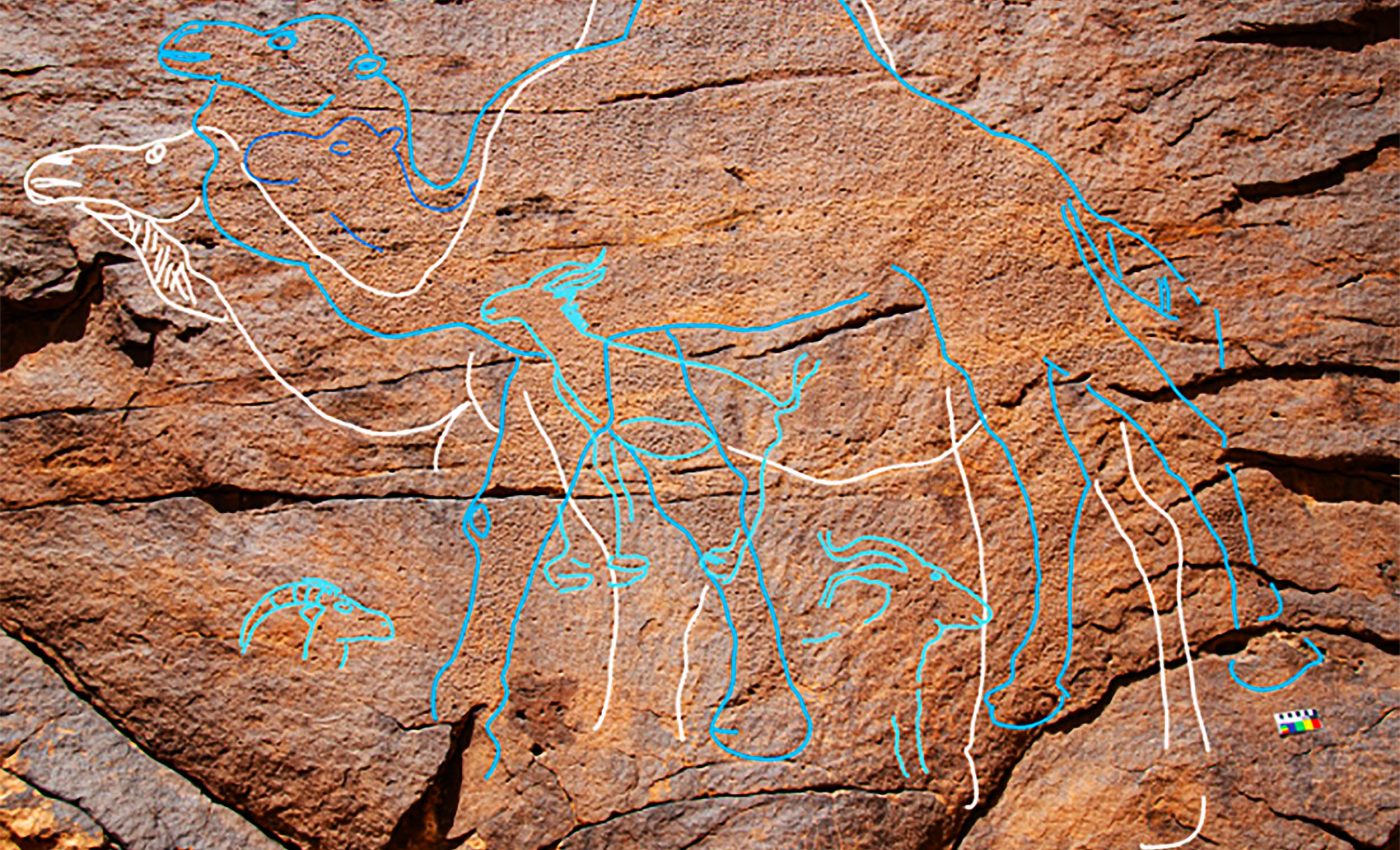
Camels drawn on rocks pointed the way to ancient Arabian watering holes
As northern Arabia emerged from the bone-dry chill of the Last Glacial Maximum, people moved back into the desert’s interior – following the return of seasonal water.
On towering cliffs and open rock faces, they left something unforgettable: sweeping panels of life-sized animals carved in stone.
The engravings, dated to roughly 12,800 to 11,400 years ago, read like bold signatures across a newly livable landscape.
An international team working under Saudi Arabia’s Heritage Commission and the Green Arabia Project surveyed three previously unexplored scarps – Jebel Arnaan, Jebel Mleiha, and Jebel Misma – along the southern edge of the Nefud Desert.
Researchers identified more than 60 rock art panels bearing 176 animal figures.
Arabia desert rock art
The engravings cluster in a window of time when ephemeral lakes and pools reappeared after extreme aridity. Sediment analyses from nearby basins confirm the comeback of seasonal water.
Those patches of blue pulled people inward. The art suggests they did more than visit. They claimed, crossed, and remembered these places.
“These large engravings are not just rock art – they were probably statements of presence, access, and cultural identity,” said lead author Maria Guagnin from the Max Planck Institute of Geoanthropology.
Life-sized animals pointed to water
Most panels show camels, ibex, equids, gazelles, and aurochs, rendered with striking realism. One hundred thirty figures are life-sized and naturalistic.
Some stretch up to 9.8 feet (three meters) long and over 6.6 feet (two meters) high.
Unlike many Arabian engravings tucked into crevices, key panels at Jebel Mleiha and Jebel Arnaan were carved onto cliff faces up to 128 feet (39 meters) tall.
One panel would have required precarious climbing and hours of work on a narrow ledge. The effort alone signals importance.
Carvings guide ancient journeys
The placement is not random. Panels sit where water once pooled and along likely corridors through the escarpments.
“The rock art marks water sources and movement routes, possibly signifying territorial rights and intergenerational memory,” said co-lead author Ceri Shipton from the Institute of Archaeology at University College London.
In a land where rain is fickle and distances sprawl, an image could stand in for a claim. Or a warning. Or a welcome. In every case, it says: people were here, and they planned to return.
Arabian rock art linked cultures
Stone tools and ornaments help flesh out the picture. The team recovered Levantine-style El Khiam and Helwan points, green pigment, and dentalium shell beads.
Together, these finds hint at links to Pre-Pottery Neolithic communities in the Levant. Ideas, objects, and perhaps people moved across long distances. Yet the art itself is unmistakably local.
“This unique form of symbolic expression belongs to a distinct cultural identity adapted to life in a challenging, arid environment,” said Faisal Al-Jibreen of the Heritage Commission at the Saudi Ministry of Culture.
Scale, subject, and prominent placement set these engravings apart from better-known rock art traditions in Arabia. They feel purpose-built for visibility – billboards of belonging on the desert’s edge.
Art marks climatic threshold
The dates fall into a narrow band: just after the hyper-arid peak of the Last Glacial Maximum (LGM) and before the fully developed Holocene lifeways of the region.
That makes the panels rare evidence of a threshold moment. As water returned, groups expanded into the interior and stitched routes between basins. The carvings likely marked those nodes and paths, turning fresh lakes into places with names, stories, and rules.
The figures are deeply pecked and abraded, with confident outlines and careful anatomy. Camels stand with long necks and high humps; wild cattle carry heavy heads and sweeping horns.
The artists understood both stone and animal. On the tallest walls, even choosing a surface required judgment. Tool scars, pigment traces, and the climb itself all speak to a practiced craft.
Panels signal people’s presence
Panels that mark water are also panels that mark people. In a fluctuating climate, such signals could reduce conflict, coordinate movement, or reinforce alliances.
They could teach younger generations where to find water when the sky refuses. In that sense the images are infrastructure – part memory bank, part boundary marker, part storytelling canvas.
For archaeologists, northern Arabia between the LGM and the Holocene has long been a thin chapter. The new sites change that.
“The project’s interdisciplinary approach has begun to fill a critical gap in the archaeological record of northern Arabia between the LGM and the Holocene, shedding light on the resilience and innovation of early desert communities,” said Michael Petraglia, head of the Green Arabia project.
By tying art to dated sediments and artifacts, the study anchors a pulse of interior occupation to a clear environmental driver: the return of seasonal water.
Next steps for Arabia’s rock art
More panels likely wait along the Nefud’s southern margin and beyond.
Systematic mapping, more sediment coring, and targeted excavations around panels could tighten dates and test how engravings relate to campsites and trails.
Use-wear and pigment chemistry may reveal sequences of engraving and repainting. Shell beads and point styles can refine the story of contacts with the Levant.
The big picture is already powerful. As the desert softened its grip, people stepped back in and wrote themselves into the rock – at a scale you can see from far across the plain.
The animals are beautiful. The message is bolder still: we belong here.
The study is published in Nature Communications.
—–
Like what you read? Subscribe to our newsletter for engaging articles, exclusive content, and the latest updates.
Check us out on EarthSnap, a free app brought to you by Eric Ralls and Earth.com.
—–













